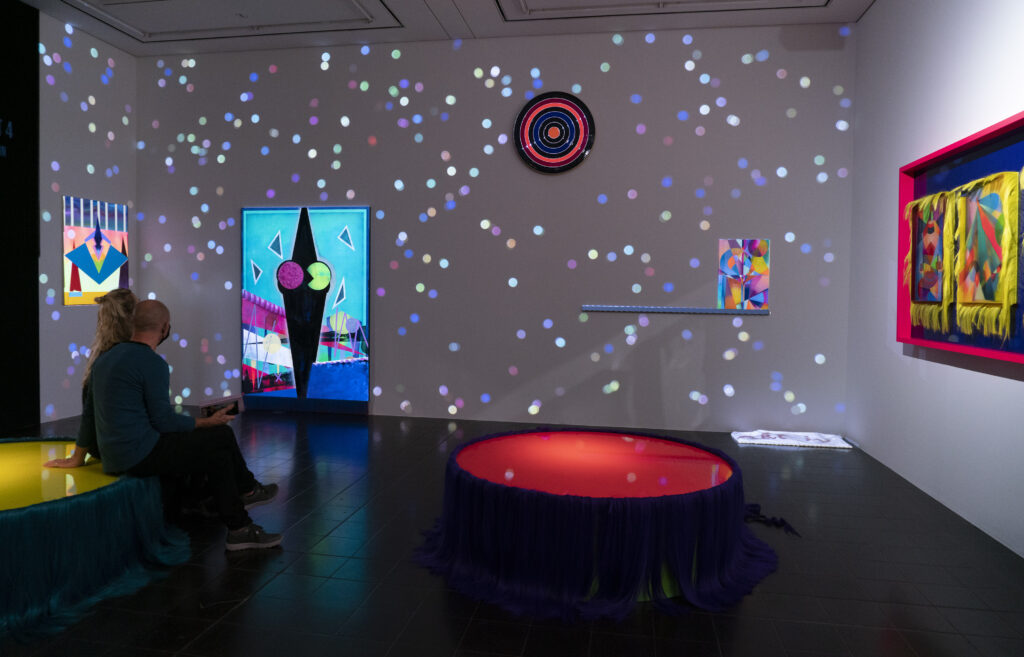THE ABSURD BEAUTY OF SPACE. 7 ARTISTS VS. UNGERS, Hamburger Kunsthalle, Galerie der Gegenwart

Akt iv 
Akt vi 
Akt vi 
Akt ii 
Akt i
“Abstract forms, glowing colours and dynamically flowing video projections dominate the space. Dana Greiner (b. 1988 in Munich, lives in Munich) challenges us with static objects that yet seem to undergo metamorphoses, sounds that materialise along the walls, and fluctuating light that steers our perception. Two plump pompoms invite us to try to reconstruct Greiner’s perfor- mance setting in seven acts. Viewing the installation as a whole, we quickly lose track of what is going on. We are called upon to engage with the constant- ly expanding dimensions, to seek out alternate points of view and perspectives, and thus to react in some way to the changing arrangements. The surrounding exhibition architecture becomes a stage, with the viewers as actors.” (source: https://www.hamburger-kunsthalle.de/sites/default/files/begleitheft.pdf)

Looking through the fringe
Text by Miriam Stoney:
At first there is a hard edge and it indicates an abrupt end, an absolute limit. As if in defiance, innumerable fibres, hairs or threads sprout off the threshold into the fray of possibility. Brushes, bangs, tentacles, fronds, fringes. Some are short, bristled and stiff; some are endlessly flowing and seductive. The edge can be forgotten, for the time being. The decoration of a boundary calls its efficacy into question, and rather draws attention to it as a point of passage. In Dana Greiner’s exhibitions, fringes can be viewed spatially, formally or iconographically, leading viewers through different possibilities of perception and interpretation. The arrival at one conclusion is always undermined by the desire to pass through the next portal, to where everything might be quite different again (Akt 2).
Dana Greiner stages interactions between mediums as though one were observing the other through a glitter string curtain, tempted to join the party on the other side. The aptitude with which she handles pigment, picture plane, material, light, colour and music demonstrates the kind of socio-technical cognition required to negotiate across their divergent properties, to pass from one to another. However, it would be a mistake to suggest that she begins at painting and makes her way from there. Rather, the introduction of moving images cast on the exhibition walls, for example, inserts a new temporality into the picture plane, which unbinds pigments to allow it to diffuse freely into the viewer’s space of perception. Each medium undergoes a soft transition in its encounter with another, which can be reversed by the cue that signals the beginning of the next act.
The dynamism of this approach is embedded in Greiner’s paintings themselves. It can be difficult to characterise her work in conventional art historical terms of ‘abstraction’, ‘figuration’ or ‘Op Art’, since they can be all of these things at once, or none of them at all. Perhaps it depends upon the role that painting is given in the context it is being viewed, which in Greiner’s case will usually have a theatrical foil: painting as protagonist, actor, narrator, director… or stage directions? Take the sweeping brush, brandished like a weapon across the feminised body of a composition of triangles in fetischistisches mamifest. The broom handle points directly to the spot of pleasure on the black, yonic form, but it also wields its own whip and moreover, it is not placed in, but on the picture plane: it’s a real sweeping brush, and it’s good for something. This is no manifesto, but a mamifesto, of the mother – the most multivalent of beings – who cleans or fucks, depending on how you get to know her.
The luxury of such uncertainties is rarely freely granted. Dana Greiner shows us what can happen when hard lines are blurred in motion. In doing so, her exhibitions stage the transformations that question the view of art as a fixed, capital asset. The painting that brazenly offers itself up as advertising space subverts the finality of the artistic gesture to underscore the capriciousness of markets in which we are all invested – as consumers, producers and products. Should we be ashamed of ourselves, for what we reproduce every time we look and consume? I’d rather take to the fringes, where there is the promise of choice and concealment in making it; the possibility of seeing a different image in the same painting; of being for and against, at the very same time.
Back to overview